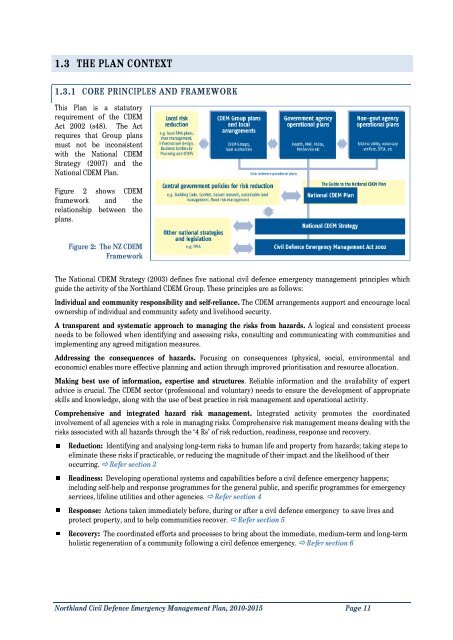Northland Civil Defence Emergency Management Plan, 2010
Northland Civil Defence Emergency Management Plan, 2010
Northland Civil Defence Emergency Management Plan, 2010
- No tags were found...
Create successful ePaper yourself
Turn your PDF publications into a flip-book with our unique Google optimized e-Paper software.
1.3 THE PLAN CONTEXT1.3.1 CORE PRINCIPLES AND FRAMEWORKThis <strong>Plan</strong> is a statutoryrequirement of the CDEMAct 2002 (s48). The Actrequires that Group plansmust not be inconsistentwith the National CDEMStrategy (2007) and theNational CDEM <strong>Plan</strong>.Figure 2 shows CDEMframework and therelationship between theplans.Figure 2: The NZ CDEMFrameworkThe National CDEM Strategy (2003) defines five national civil defence emergency management principles whichguide the activity of the <strong>Northland</strong> CDEM Group. These principles are as follows:Individual and community responsibility and self-reliance. The CDEM arrangements support and encourage localownership of individual and community safety and livelihood security.A transparent and systematic approach to managing the risks from hazards. A logical and consistent processneeds to be followed when identifying and assessing risks, consulting and communicating with communities andimplementing any agreed mitigation measures.Addressing the consequences of hazards. Focusing on consequences (physical, social, environmental andeconomic) enables more effective planning and action through improved prioritisation and resource allocation.Making best use of information, expertise and structures. Reliable information and the availability of expertadvice is crucial. The CDEM sector (professional and voluntary) needs to ensure the development of appropriateskills and knowledge, along with the use of best practice in risk management and operational activity.Comprehensive and integrated hazard risk management. Integrated activity promotes the coordinatedinvolvement of all agencies with a role in managing risks. Comprehensive risk management means dealing with therisks associated with all hazards through the ‘4 Rs’ of risk reduction, readiness, response and recovery.Reduction: Identifying and analysing long-term risks to human life and property from hazards; taking steps toeliminate these risks if practicable, or reducing the magnitude of their impact and the likelihood of theiroccurring. Refer section 3Readiness: Developing operational systems and capabilities before a civil defence emergency happens;including self-help and response programmes for the general public, and specific programmes for emergencyservices, lifeline utilities and other agencies. Refer section 4Response: Actions taken immediately before, during or after a civil defence emergency to save lives andprotect property, and to help communities recover. Refer section 5Recovery: The coordinated efforts and processes to bring about the immediate, medium-term and long-termholistic regeneration of a community following a civil defence emergency. Refer section 6<strong>Northland</strong> <strong>Civil</strong> <strong>Defence</strong> <strong>Emergency</strong> <strong>Management</strong> <strong>Plan</strong>, <strong>2010</strong>-2015 Page 11
















